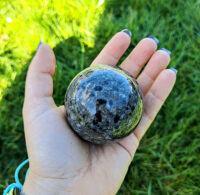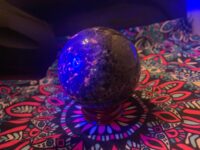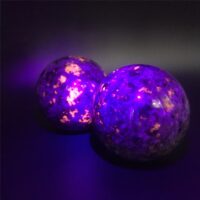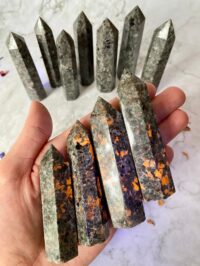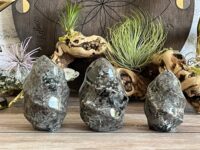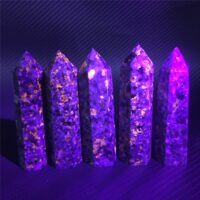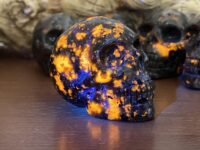Are you looking for something special and unique to add to your rock collection? Look no further than Yooperlite. This mysterious rock found only in the Upper Peninsula of Michigan will amaze you with its glow-in-the-dark properties. It is a special type of syenite containing a mineral called sodalite that produces a soft blue-green glow when exposed to ultraviolet (UV) light. Whether you’re a science enthusiast looking for more information about these rare finds or someone interested in embarking on your own Yooperlite hunt, this article will help explain what makes these glowing gemstones so special.
What is a Yooperlite?
First spotted on the beaches of Michigan’s Upper Peninsula in 2017, Yooperlite is a type of fluorescent syenite that contains the rare blue mineral sodalite. Sodalite makes these rocks unique and gives them their luminescent properties. It emits a soft orange-yellow glow under ultraviolet light, making it a sight to behold.
The intensity of this glow can vary depending on the amount of Sodalite present in the rock, but the rocks will still glow regardless. These rocks were named after their home state’s nickname: “the U.P.” or “Yoopers”. Not only are they visually stunning, but they also have a fascinating origin story of being created by ancient lava flows.
How Did Yooperlites Form?
Yooperlites were formed through a combination of volcanic eruptions and glacial movement. They formed about a billion years ago when a spectacularly violent geologic period saw North America attempt to tear itself in two. The Midcontinental Rift formed, creating unimaginable volcanic eruptions and 360,000 cubic miles of lava – one eruption produced an ocean of lava more than 1,700 feet deep. Despite this activity, the rift ultimately failed to split North America, much of which lies beneath Lake Superior today. Near the modern shore of Lake Superior, a large body of magma hardened beneath the ground to form syenite containing Sodalite known as “glowdalites”.
The last ice age around 10,000 years ago scraped these glowdalites southward and dispersed them across the shores of the Great Lakes, leaving behind chunks of Yooperlite for us to find today. The combination of the glacial movement and subsequent weathering wearing away at the rock’s surface creates the perfect conditions for these rocks to be found.
The Yooperlite Story
Erik Rintamaki discovered fluorescent syenite pebbles along the shore of Lake Superior in Michigan’s Upper Peninsula and dubbed them “yooperlites”. California geologist Gabe Reyna identified them as Sodalites.
Erik’s story began 15 years prior when he taught his brother-in-law Jason Klein to find agates on Lake Superior. Inspired by literature from the Fluorescent Mineral Society, Erik invested in a cheap UV flashlight and discovered two small yooperlites that June. He found more Yooperlites up to 5 pounds in size with upgraded LED UV torches and shortwave lamps.
Guide to Finding Yooperlites
Yooperlites don’t need to be mined or quarried, unlike many gems and minerals. With the right equipment and knowledge, you can find these special rocks on the beaches and shorelines of Lake Superior. Let’s look at how you can start your hunt for Yooperlites.
Where Do You Find Yooperlites?
Yooperlites, first discovered in Michigan’s Upper Peninsula, can be found anywhere in North America. To increase the odds of finding Yooperlites, search for rocky shorelines free from cliffs or hills near their source in the Upper Peninsula.
Beaches with sugar sand should be avoided since stones are not likely to be found here. Limestone rocks indicate a low likelihood of finding Yooperlites. They would most likely be concealed under tons of locally eroded rocks. However, you should remember that taking anything from any National Park or area is illegal.
When to Find Yooperlite?
Yooperlites can be found year-round. Many areas near beaches are seasonal, so the best times for finding Yooperlites are in the Fall and early Winter when storms and waves from Lake Superior alter the shoreline daily. The weather is also mild during these seasons, with fewer bugs and tourists. Spring is also an ideal time as the ice from the lake and storms “flip” the beach, revealing fresh stones to check out. Furthermore, the Yooperlites emerge from the snow during spring and are more easily noticeable.
What Do You need to Find Yooperlite?
There are a few basic tools you’ll need to find Yooperlites:
Black Light UV Flashlight – A black light flashlight is essential for finding Yooperlites. You need a UV flashlight that emits longwave ultraviolet radiation (UV wavelength of 360 to 400nm)
A headlamp – A headlamp provides hands-free illumination when you’re making your way around the beach.
A sturdy bag – You’ll need a sturdy bag to transport and store any Yooperlite specimens you find, like a mesh or canvas sack or an Army surplus duffel bag.
Extra batteries – Bring enough batteries to last your entire collecting trip.
Glow Sticks – Glow sticks are an excellent way to mark the area where you find Yooperlites. It’s a great way to track which rocks have already been checked and which ones still need examining.
Map – A map of the area you plan to visit is especially helpful if it includes landmarks and other features.
Snacks and drinks – Bring plenty of snacks and drinks to keep you fuelled up for your treasure hunt.
These are the basic tools you need to find Yooperlites along the shores of Lake Superior. With these items in hand and some knowledge about where to look, nothing is stopping you from finding your Yooperlite specimens!
What to Wear When Looking for Yooperlite Rocks?
When searching for Yooperlite rocks, the key is to wear clothing that will keep you warm and comfortable while allowing you to move freely. The following items are recommended for your Yooperlite hunt:
- Footwear: Finding Yooperlites requires lots of walking, so bring comfortable footwear. Sturdy shoes or boots are ideal as they provide enough support for your feet while walking on rocky terrain. Ensure your shoes have enough traction, as you don’t want to slip or fall when exploring the shoreline.
- Clothing: Remember that function should be the main priority when choosing clothing for a Yooperlite rock-hunting adventure! Wear lightweight yet warm clothes for the cooler temperatures in Michigan’s UP. Choose items made from breathable materials like cotton or linen to stay cool and comfortable even during long hikes. A good option is layering clothes – you can easily adjust depending on the temperature. Don’t forget waterproof clothing, too, since beach weather changes quickly.
- Gloves: Wear gloves when searching for Yooperlites to protect your hands when picking up stones. Leather work gloves are a great option as they provide more protection while allowing you to feel the stones.
- Hat: A hat is essential when going out in search of Yooperlites. It will keep the sun out of your eyes while also providing warmth. Choose a waterproof hat or one with a wide brim to protect yourself from rain and sun.
You’ll be ready to go on your Yooperlite searching adventure with the right clothing and supplies. Remember to respect the environment and other beachgoers and follow safety guidelines.
Tips and Tricks for Finding Yooperlites
When it comes to finding Yooperlites, a few tips, and tricks can help increase your chances of success. They include:
Be Familiar With The Area – Knowing the area you’re exploring will help you narrow down which rocks to search for Yooperlites. Familiarize yourself with the shoreline, landmarks, and other features to maximize your chances of success.
Check The Weather – Always check the weather and marine forecasts before heading out. Weather can greatly impact your treasure hunt, so plan accordingly. You don’t want to be stuck in a thunderstorm or strong winds.
Check Areas with Recent Storm Activity – The stones may have been moved around during a storm, so it’s worth checking areas with recent storm activity. You may find Yooperlites that weren’t there before.
Check For Marine Life – When searching for Yooperlites, look carefully for living creatures that may have made their home amid the stones, such as crabs or sea stars! Be respectful and do not disturb any marine life you encounter during your search; admire them from afar and continue your hunt.
Look After Dark – Because Yooperlites emit a brilliant glow when exposed to ultraviolet light, it’s best to look for them after dark. Bring a UV light with you to maximize your chances of finding them.
Join A Local Rock Collecting Community – Joining a local rock collecting community is one of the best ways to increase your chances of finding yooperlites. Not only will these communities provide helpful advice about where to look for these rare stones, but many also offer group trips where members can go out together looking for specimens.
Take Caution – Finally, keep in mind that the shoreline can be an unpredictable and dangerous place. Be sure to stay on designated paths, follow safety guidelines, and always use caution when searching for Yooperlites.
Following these tips and tricks will prepare you to search for this rare and beautiful stone. You never know what you might find – it could be the experience of a lifetime.
Yooperlite: Mineralogy
Yooperlite primarily comprises syenite, an igneous rock formed from cooled magma. It contains several minerals, such as microcline feldspar, Sodalite, nepheline, cancrinite, and pyroxene. All are responsible for giving Yooperlite its distinct glow when exposed to ultraviolet light. Sodalite in Yooperlite displays a strong hackmanite-like fluorescent in response to longwave UV illumination.
The rock under incandescent illumination and binocular stereozoom microscope, the mineral appears very pale gray with hints of yellow and teal. It also has a refractive index between 1.480 and 1.490, consistent with Sodalite. Under a petrographic microscope, this material reveals an isotropic appearance when observed under crossed polarizing light.
Yooperlite Meaning, Benefits, and Healing Properties
This stone is unique and special, so it’s no wonder that many people believe it has some powerful healing energies. Let’s look at what Yooperlite means, its benefits, and how it can be used for healing.
Yooperlite Physical Benefits
In the healing practice of lithotherapy, Yooperlite boasts identical properties as Sodalite—after all, it is a syenite with fluorescent Sodalite within. Some of the physical benefits that this mineral is believed to offer to include the following:
Improves Cellular Hydration – Yooperlite is believed to improve cellular hydration due to its chemical composition, allowing for better nutrient intake and easier disposal of waste products.
Promotes Regulation of Blood Pressure and Heart Rate – The high mineral content of this stone is thought to act as a regulator for the cardiovascular system, helping to keep blood pressure and heart rate in check.
Reduces Stress & Anxiety – This stone is considered an excellent stone for managing stress and anxiety due to its ability to promote relaxation. It can also help improve mental clarity and reduce fatigue.
Eases Skeletal System Issues – Yooperlite is beneficial in relieving pain associated with skeletal system issues, such as joint stiffness or arthritis.
It Soothes Muscle Tension – The soothing qualities of Yooperlite can help to reduce muscle tension and spasms, making it an ideal remedy for those suffering from physical exhaustion or injury.
Others:
Yooperlite can also reduce the discomfort of menopause, inflammation, fever, headaches, and sinus infections. Additionally, Yooperlite has been known to ease digestion issues while aiding those on a diet with their weight loss goals.
Yooperlite Emotional Benefits
In addition to its physical benefits, this stunning stone is said to have several emotional benefits as well:
Promotes Logic and Truth – Yooperlite is believed to open the mind, allowing for more logical and truthful thinking.
Fosters Inner Calm – This stone can act as a calming force in times of stress or confusion, allowing us to stay centered and focused.
Enhances Self-Acceptance – Its soothing energy helps to reduce feelings of fear or insecurity, allowing us to embrace ourselves fully.
Promotes Positive Attitude – This stone helps to replace negative thoughts with more positive and uplifting ones, helping to cultivate an optimistic outlook.
Creativity and Dexterity – Yooperlite is believed to enhance creativity and dexterity, which could benefit artists or those in the creative field.
This powerful stone can help us connect more deeply with ourselves and the world, allowing us to understand our motivations and desires better.
Yooperlite Spiritual Benefits
On a spiritual level, this stone has several distinct benefits:
Connect with Nature – To better understand nature’s intelligence and how it applies to our lives, many people use crystals as tools for meditation and connection. Yooperlite has a bright, vibrant energy that can help connect us with nature’s wisdom and provide insight into our personal growth. Additionally, this crystal can bring balance and clarity during stress or confusion.
Promotes Multileveled Understanding – Yooperlite is associated with enhanced creativity, clarity, and world understanding. This crystal can help open up spiritual realms and inspire our lives.
Enhance Psychic Abilities – Working with these special stones can help enhance psychic abilities such as clairvoyance or telepathy by amplifying intuitive messages from the spiritual world. This is especially beneficial for those just starting on their spiritual journey as it helps open up channels of communication between yourself and your spirit guides or higher self.
Whether you are simply curious about its spiritual potential or seeking to unlock your inner power, Yooperlite is a powerful stone to work with on your journey. It can help you open up to new possibilities and allow for more spiritual awakening and connection with the universe.
Yooperlite Uses & Metaphysical Properties
As a highly versatile stone, Yooperlite has a wide range of uses and powerful metaphysical properties. The following are some of the most common uses of this stunning crystal:
Wearing Yooperlite Jewelry
Wearing Yooperlite jewelry is a great way to keep the healing energy of this stone close to you throughout the day. It looks beautiful, and its metaphysical properties make it an ideal accessory for everyday wear.
Some common pieces of Yooperlite jewelry include:
Yooperlite Necklaces with Pendants – Necklaces with Yooperlite pendants are popular and look stylish while providing a powerful energetic boost.
Yooperlite Bracelets – Bracelets made with Yooperlite are a great way to keep this crystal’s energy close to your heart. They can be worn alone or stacked with other bracelets for a more eye-catching look.
Yooperlite Beads – Yooperlite beads look fabulous when strung together in a bracelet or necklace. The natural beauty of the stone is highlighted when in its raw form and can help to promote emotional balance throughout the day.
Yooperlite and Chakras
Chakras are energy centers in the body that can become blocked due to stress or negative emotions. Working with crystals can help balance and clear these chakras, allowing for a more harmonious energy flow throughout your system. Yooperlite is associated with the Throat Chakra (Vishuddha), Third-Eye Chakra (Ajna), Sacral Chakra (Swadhisthana), and Solar Plexus Chakra (Manipura).
Throat Chakra (Vishuddha)
The Throat Chakra, located in the neck, is said to govern both communication and self-expression. It is believed that when the Throat Chakra is blocked or imbalanced, one may struggle to express themselves effectively or feel unheard, leading to anxiety and fear. Incorporating Yooperlite into meditation or placing it on the throat during healing practices may assist in balancing and activating this powerful chakra.
Third-Eye Chakra (Ajna)
This chakra is responsible for intuition, perception, and spiritual insight. Some believe holding or meditating with Yooperlite can activate and balance their Third-Eye Chakra, creating a heightened sense of awareness and spiritual connection. So if you’re looking for a new way to enhance your spiritual practice or explore the world of crystals and minerals, consider the fascinating world of Yooperlite and its connection to the Third-Eye Chakra.
Sacral Chakra (Swadhisthana)
The Sacral Chakra is a vital energy center located in the pelvic area. It is responsible for our creativity, sensuality, and emotional expression. When this chakra is blocked, one may experience feelings of negativity or depression. Working with Yooperlite can help balance and activate this chakra, inspiring new ideas and thoughts while promoting emotional stability. You may also experience increased confidence and a greater ability to express yourself.
Solar Plexus Chakra (Manipura)
The Solar Plexus Chakra is located between the ribcage and navel and is responsible for energy distribution. When in balance, it can strengthen the immune and digestive systems. When out of balance, it can lead to a low tolerance to infection, hormone disorders, or food intolerance. Spiritually, when balanced, it allows one to interpret the world through personal thoughts and emotions, whereas out of balance, it causes fear of disappointing or subordinating oneself to others. Yooperlite is known to activate this chakra, helping one to express themselves honestly and confidently.
Meditation With Yooperlite
Yooperlite, a captivating reminder of nature’s beauty and its ability to provide solace from daily stresses, holds incredible power for meditation. Incorporating this natural wonder into your meditation practice facilitates moments of stillness, clarity, and heightened awareness. This unique stone also aids in directing your attention to the present moment—an essential element for a successful meditation practice. Introducing Blue Amethyst to your meditation space can further amplify the calming and transformative qualities, enhancing your journey towards inner peace and mindfulness.
Since it has Sodalite inclusions, when used in meditation, its calming energy may assist in bringing positive energy into your life while clearing away negative energies and blockages. It can also open up the Third Eye, allowing you to open up your intuition and tap into the depths of your inner world.
To use Yooperlite in meditation, begin by finding a comfortable position, such as seated or lying down. Hold the crystal in one hand, close your eyes, and breathe deeply. As you focus on your breath and keep your mind free from distraction, allow the energy of Yooperlite to fill your body and mind. As you do this, focus on any intention or visualization that comes to you during meditation. When you feel complete, open your eyes and thank yourself for honoring your spiritual journey with Yooperlite.
Yooperlite Feng Shui
Feng shui is an ancient Chinese practice designed to bring harmony and balance into one’s home. It’s based on the idea that everything in our environment can affect our lives – from the furniture we choose to how clutter is organized.
Yooperlite is associated with Water energy, known for its stillness, quiet strength, and purification. When used in feng shui practice, Yooperlite can help bring potentialities to life and provide balance as your life unfolds and flows. It can purify, cleanse, and transform stagnant energy into positive vibes. Creating a balanced space with Yooperlite feng shui can invite positive energy into your home and create a peaceful atmosphere.
Moreover, the introduction of Blue Quartz to your Yooperlite feng shui enhances its calming energy, elevating the ambiance of your home. Strategically placing these crystals around your house or office fosters clarity, focus, and insight, contributing to a peaceful atmosphere. Utilize them during work to promote concentration, creativity, and an overall sense of positive energy.
The combination of Yooperlite and Blue Quartz not only enhances the energetic flow but also serves as an eye-catching focal point, elevating the aesthetic appeal of your living space. Embrace the power of these crystals to create a harmonious environment that radiates positive vibrations throughout your home.
Yooperlite Zodiac Sign
Yooperlite is associated with the zodiac sign Sagittarius, known for being analytical, outgoing, and proactive. It’s a perfect stone for those looking to find balance in their life and bring clarity into their thoughts. The calming energy of this stone can help clear mental fog, allowing one to make more rational decisions. Additionally, the energy of Yooperlite can bring joy and contentment into one’s life. It is believed to be a powerful stone for those seeking to explore the depths of their inner world and gain insight into their true nature.
How to Care for Yooperlite?
Yooperlite is a durable and hardy stone that needs to be cared for. The following are some tips on how best to care for your Yooperlite:
Storage & Handling
It’s best to store your Yooperlite specimens in a clean, dry place away from direct sunlight or any other strong light source. This will help protect the colors from fading over time. When handling your Yooperlites, always use a soft material, so the surface is not scratched or damaged. You should also avoid using harsh chemicals when cleaning your specimens as this could damage their delicate structure.
Cleaning & Displaying
When cleaning, use a soft cloth with lukewarm water and mild soap (if necessary). Do not use abrasives or harsh chemicals, which could scratch or damage the stone’s delicate surface. Once cleaned, you can display your Yooperlite collection proudly by incorporating it into jewelry pieces such as pendants and earrings, creating decorative items like paperweights, or simply placing them on shelves or tables where they can be admired.
Heat Exposure
Yooperlite is a fragile stone and can be easily damaged by extreme temperatures. It’s best to keep it away from direct heat sources, such as fireplaces, stoves, and radiators. When using Yooperlite in jewelry or other applications that might come into contact with heat, use caution and ensure the piece is not exposed to temperatures that could cause damage.
Yooperlite Shapes and Forms
Yooperlite Spheres
The round shape of Yooperlite spheres makes them perfect for jewelry or decor pieces. The spherical shape reflects light evenly, meaning that no matter where you view it from, you will be able to appreciate its dazzling luminescence.
The smooth surface makes it pleasant to hold in your hand; their portability makes them ideal for bringing on hikes or camping trips. Additionally, these spheres are a great gift idea for any special occasion.
Yooperlite Towers
Tower-shaped Yooperlite radiates an aura of sophistication with its tall stature. These multicolored stones can be used as decor or focal points in your garden or yard.
They also make great conversation pieces when placed on mantles or end tables – people won’t resist asking questions about them. And if you’re looking for something unique to give someone special this season, towers provide the perfect solution.
Yooperlite Skulls
One of the most interesting shapes for Yooperlite is skull-shaped specimens. With their intricate designs and eerie luminescence, these skulls can add a unique touch to any room in your home.
Place them on shelves or desks with other collectibles and watch them come alive under UV light. They are also perfect for giving away as spooky stocking stuffers during Halloween or adding an extra bit of mystery to costume parties during the holidays.
Yooperlite Value
Yooperlite is a rare and sought-after stone, making it highly valuable. The global industry standard for the cost of stones is determined by a scale per carat, with larger pieces commanding higher prices. The unique color and glow of specimens from Michigan’s Upper Peninsula make them especially sought-after, with prices that range from $26 per carat.
Yooperlite vs. Sodalite
Yooperlite is a name given to rocks that consist of syenite-rich fluorescent sodalite. The rock fluoresces an orange or yellow color under ultraviolet light. On the other hand, Sodalite is a mineral found worldwide and does not require UV lighting to see its beautiful blue hue.
Yooperlite vs. Emberlite
Yooperlites are a variety of sodalite-rich igneous rock known as nepheline syenite. It has a unique orange or yellow fluorescence when exposed to UV light. Emberlite is a type of volcanic rock that contains fluorescent hyalite opal, which glows blue when exposed to UV light.
Experience The Glow of This Fascinating Rock From Michigan’s Upper Peninsula
The mysterious glow-in-the-dark rock known as Yooperlite has captivated people worldwide since it was first discovered in 2017. With its unique origin story and scientific value, this special stone provides plenty of reason for rock collectors, geologists, and nature lovers to seek out its hidden beauty beneath Michigan’s surface. Whether you are looking for a rare souvenir or want to explore the U.P., keep an eye out for these mysterious rocks – you never know what you’ll find.
Frequently Asked Questions about Yooperlite
What is Yooperlite?
Yooperlite is a type of rock that is found almost exclusively in the Upper Peninsula of Michigan. It is a variety of the mineral sodalite that glows under ultraviolet light. Yooperlite was first discovered in 2017 by a rock enthusiast named Erik Rintamaki, who was searching for rocks along the shores of Lake Superior.
Where can I find Yooperlite?
Yooperlite is primarily found along the shores of Lake Superior in the Upper Peninsula of Michigan. It can also be found in other locations in Michigan and occasionally in other states, but the vast majority of Yooperlite specimens come from Michigan’s Upper Peninsula.
What does Yooperlite look like?
To the naked eye, Yooperlite looks like an ordinary dark rock, but under ultraviolet light, it glows a bright greenish-yellow color. The glow is caused by the presence of fluorescent minerals, specifically the mineral sodalite, which is a key component of Yooperlite.
Is Yooperlite rare?
Yes, Yooperlite is relatively rare. While it can be found in other locations besides the Upper Peninsula of Michigan, it is not commonly found in large quantities. Additionally, the fact that it only glows under ultraviolet light makes it difficult to identify without specialized equipment, which makes it even rarer.
What makes Yooperlite glow?
Yooperlite glows under ultraviolet light because of the presence of fluorescent minerals, specifically the mineral sodalite. When the sodalite absorbs ultraviolet light, it emits light of a different wavelength, which gives Yooperlite its distinctive glow.
Can I collect Yooperlite?
Yes, Yooperlite can be collected, but it is important to follow all laws and regulations related to rock collecting in the area where it is found. Additionally, it is important to be respectful of the environment and to avoid damaging the natural habitats where Yooperlite is found.
How do I know if I have found Yooperlite?
The easiest way to determine if you have found Yooperlite is to shine a black light or ultraviolet flashlight on the rock. If it glows bright greenish-yellow, then you have likely found Yooperlite. If you are unsure, you can also take the rock to a local rock shop or geology museum for identification.
How do I clean Yooperlite?
Yooperlite can be cleaned using mild soap and water, but it is important to avoid using any harsh chemicals or abrasive cleaning tools that could damage the rock’s surface. It is also important to dry the rock thoroughly after cleaning to prevent any water damage.
What can I do with Yooperlite?
Yooperlite is often used for decorative purposes, such as in rock collections or as a unique and eye-catching addition to a garden or landscaping project. It can also be used in jewelry-making or as a component in other artistic creations.
Is Yooperlite valuable?
The value of Yooperlite varies depending on factors such as the size, quality, and rarity of the specimen. While some Yooperlite specimens can be quite valuable, most are relatively inexpensive and are primarily valued for their unique appearance and interesting properties.
Can Yooperlite be found outside of Michigan?
While Yooperlite is primarily found in the Upper Peninsula of Michigan, it can occasionally be found in other locations throughout the United States and even in other countries. However, the vast majority of Yooperlite specimens come from Michigan.
Are there any dangers associated with searching for Yooperlite?
As with any outdoor activity, there are potential hazards associated with searching for Yooperlite. It is important to be aware of your surroundings and to take precautions such as wearing appropriate footwear and clothing, using insect repellent, and carrying plenty of water. Additionally, it is important to be respectful of the environment and to avoid damaging the natural habitats where Yooperlite is found.
Can Yooperlite be used in jewelry-making?
Yes, Yooperlite can be used in jewelry-making. Its unique appearance and glowing properties make it a popular choice for jewelry designers who are looking for something out of the ordinary. Yooperlite is often set in sterling silver or other precious metals to create beautiful and unique pieces of jewelry.
How long does Yooperlite’s glow last?
The length of time that Yooperlite glows can vary depending on the specific specimen and the strength of the ultraviolet light source. In general, the glow will last for a few minutes after the light source is removed, but it will gradually fade over time.
Is Yooperlite radioactive or harmful in any way?
No, Yooperlite is not radioactive or harmful in any way. It is safe to handle and to use for decorative or artistic purposes.
How did Yooperlite get its name?
Yooperlite gets its name from “Yooper,” which is a term used to refer to people from Michigan’s Upper Peninsula. The term was coined from the initials “U.P.,” which stands for “Upper Peninsula.” The “lite” part of the name comes from the fact that Yooperlite is a type of rock that glows under ultraviolet light.
Is Yooperlite a type of rock or mineral?
Yooperlite is a type of rock that is composed primarily of the mineral sodalite, which is what gives it its distinctive glowing properties.
How is Yooperlite formed?
Yooperlite is formed through a process known as igneous intrusion. This occurs when molten rock, or magma, is forced into existing rock formations and then cools and solidifies. Over time, erosion and weathering can expose these formations and reveal the Yooperlite within.

